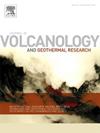Improved volcanic SO2 flux records from integrated scanning-DOAS and UV Camera observations.
IF 2.4
3区 地球科学
Q2 GEOSCIENCES, MULTIDISCIPLINARY
Journal of Volcanology and Geothermal Research
Pub Date : 2024-10-11
DOI:10.1016/j.jvolgeores.2024.108207
引用次数: 0
Abstract
Volcanic SO2 flux is a key indicator of magma influx into shallower portions of magmatic plumbing systems, and as such is central to volcano monitoring. However, observations have traditionally been challenged by a variety of technical and methodological caveats and limitations, to overcome which it is required an intercomparison of different observational techniques and, where possible, their integration. Here, we compare ∼9 years (2014 to 2022) of SO2 flux records at Stromboli obtained through (i) a near-vent (∼500 m) UV Camera system and (ii) a network of DOAS spectrometers scanning the distal (∼2 km) bulk plume. We find a large (133 t/d on average) systematic offset between the SO2 flux time-series streamed by the two observational techniques, with the flux from the scanning spectrometers being ∼200 % higher on average than UV Camera flux. We propose this mismatch to derive from a combination of (i) SO2 flux underestimation by the UV Camera, as caused by incomplete coverage of the plume (due to topography of the crater area) and radiative transfer issues in the optically dense, near-vent plume, and (ii) SO2 flux overestimation by the distal scanning spectrometers', caused by non-ideal (incomplete) atmospheric dilution of source-released gas puffs during atmospheric transport. Our analysis suggests this latter process to be dominant, imparting a positive wind speed dependence and a marked seasonality to the distal scanning spectrometers' fluxes, and causing them to significantly overestimate the source SO2 fluxes. Finally, we propose a novel integrated SO2 flux record, based on the combination of UV Camera-derived gas velocities and DOAS-derived SO2 integrated column amounts (back-calculated at source using an experimentally derived plume dilution function). We expect this SO2 flux time-series to be less affected by external factors (e.g., meteorological, illumination and volcano topography conditions) than using any of the two techniques alone and hence a better proxy of volcano behaviour. We recommend testing of the integrated UV Camera-scanning-DOAS method at other volcanoes to explore its utility for improved volcanic degassing characterization.
通过综合扫描-DOAS 和紫外线照相机观测改进火山二氧化硫通量记录。
火山二氧化硫通量是岩浆流入岩浆管道系统较浅部分的一个关键指标,因此是火山监测的核心。然而,观测工作历来受到各种技术和方法上的限制,要克服这些限制,就需要对不同的观测技术进行相互比较,并在可能的情况下进行整合。在此,我们比较了斯特龙博利9年(2014年至2022年)的二氧化硫通量记录,这些记录是通过(i)近喷口(500米)紫外相机系统和(ii)扫描远端(2千米)大体积羽流的DOAS光谱仪网络获得的。我们发现这两种观测技术所产生的二氧化硫通量时间序列之间存在很大的系统偏移(平均为 133 t/d),扫描光谱仪的通量比紫外相机的通量平均高出 200%。我们认为这种不匹配是由以下因素共同造成的:(i) 紫外相机低估了二氧化硫通量,这是由于羽流的覆盖范围不完整(由于陨石坑区域的地形)以及光学致密的近喷口羽流中的辐射传递问题造成的;(ii) 远端扫描光谱仪高估了二氧化硫通量,这是由于在大气传输过程中源释放的气团被非理想(不完全)的大气稀释造成的。我们的分析表明,后一个过程是主要的,它使远端扫描光谱仪的通量与风速呈正相关,并具有明显的季节性,从而导致它们大大高估了源二氧化硫通量。最后,我们提出了一种新的二氧化硫通量综合记录,该记录基于紫外照相机得出的气体速度和 DOAS 得出的二氧化硫综合柱量(利用实验得出的羽流稀释函数在源头进行反向计算)。我们预计这种二氧化硫通量时间序列受外部因素(如气象、光照和火山地形条件)的影响要小于单独使用这两种技术中的任何一种,因此是火山行为的更好替代物。我们建议在其他火山测试紫外线相机扫描-DOAS 综合方法,以探索其在改进火山脱气特征描述方面的用途。
本文章由计算机程序翻译,如有差异,请以英文原文为准。
求助全文
约1分钟内获得全文
求助全文
来源期刊
CiteScore
5.90
自引率
13.80%
发文量
183
审稿时长
19.7 weeks
期刊介绍:
An international research journal with focus on volcanic and geothermal processes and their impact on the environment and society.
Submission of papers covering the following aspects of volcanology and geothermal research are encouraged:
(1) Geological aspects of volcanic systems: volcano stratigraphy, structure and tectonic influence; eruptive history; evolution of volcanic landforms; eruption style and progress; dispersal patterns of lava and ash; analysis of real-time eruption observations.
(2) Geochemical and petrological aspects of volcanic rocks: magma genesis and evolution; crystallization; volatile compositions, solubility, and degassing; volcanic petrography and textural analysis.
(3) Hydrology, geochemistry and measurement of volcanic and hydrothermal fluids: volcanic gas emissions; fumaroles and springs; crater lakes; hydrothermal mineralization.
(4) Geophysical aspects of volcanic systems: physical properties of volcanic rocks and magmas; heat flow studies; volcano seismology, geodesy and remote sensing.
(5) Computational modeling and experimental simulation of magmatic and hydrothermal processes: eruption dynamics; magma transport and storage; plume dynamics and ash dispersal; lava flow dynamics; hydrothermal fluid flow; thermodynamics of aqueous fluids and melts.
(6) Volcano hazard and risk research: hazard zonation methodology, development of forecasting tools; assessment techniques for vulnerability and impact.

 求助内容:
求助内容: 应助结果提醒方式:
应助结果提醒方式:


